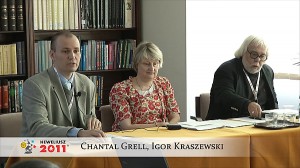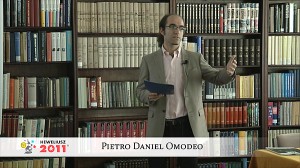Konferencja Hevelius 2011 – Sesja 6 – Maciej Jasiński
 Temat: Mieszkańcy Księżyca w Selenografii Heweliusza.
Temat: Mieszkańcy Księżyca w Selenografii Heweliusza.
W XII rozdziale swojego dzieła Selenographia Heweliusz pisze o hipotetycznych mieszkańcach Księżyca – Selenitach. Nie był on jednak pierwszym, który rozważał kwestię zamieszkania satelity Ziemi. Wzmianki o mieszkańcach Księżyca pojawiają się już u autorów starożytnych, antyczny rodowód ma też określenie „Selenita” – pojawia się po raz pierwszy w Prawdziwej historii Lukiana z Samosat, ale przypuszczalnie ukuto je wcześniej.
Poza satyrycznym tekstem Lukiana, jak również innymi pismami, które traktowały o mieszkańcach Księżyca w sposób nienaukowy, mitologiczny czy quasi-mitologiczny, zachowały się także dzieła, poruszające kwestię Selenitów bardziej metodycznie i naukowo. Przykładem takiego podejścia jest traktat Plutarcha O obliczu widniejącym na tarczy księżyca. Śladami Plutarcha podążali uczeni wczesnonowożytni, piszący o Księżycu. Należał do nich Johannes Kepler, który opisał mieszkańców Księżyca w swoim Śnie, jak również Heweliusz. Zauważmy, że Selenici nie byli głównym tematem tych prac, ale zwykle podejmowano kwestię możliwości ich istnienia.
W niniejszym wystąpieniu zostanie podjęta próba porównania Selenitów z Selenografii Heweliusza i sposobu ich przedstawienia z opisami obecnymi w innych dziełach, zarówno starożytnych, jak i współczesnych gdańszczaninowi.
materiał w języku angielskim
Maciej Jasiński (University of Warsaw):
The Inhabitants of the Moon in Hevelius’s Selenographia
In the twelfth chapter of his Selenographia Hevelius mentions the hypothetical inhabitants of the Moon – the Selenites. He was not the first to touch on the subject of the habitation of Earth’s satellite. References to the inhabitants of the Moon had already appeared in the writings of ancient authors. The name “Selenite” itself has been known since antiquity. In the preserved ancient literature it appears for the first time in A True Story by Lucian of Samosata, but was probably known earlier.
Apart from Lucian’s satirical works, as well as other preserved ancient writings that touch on the topic of inhabitation of the Moon in nonscientific, mythological or quasi-mythological ways, works have also been preserved that approach the subject of the Selenites in a more scientific and methodical way. An example of this approach is Plutarch’s treaty On the Face in the Moon. Plutarch’s method of introducing the Selenites was followed by early modern scholars who wrote about the Moon, including Hevelius and his Selenographia. Other works that refer to the inhabitants of the Moon include, for example, The Dream by Kepler. The Selenites are not the main subject of these works, but the possibility of their existence was at least mentioned by the scholars.
In this paper, the author undertakes to try to compare the Selenites in Hevelius’s Selenographia and their place in this work with descriptions of the inhabitants of the Moon in other writings. The comparison includes both ancient works and Hevelius’s contemporaries. The author tries to indicate similarities and differences between references to the Selenites in the twelfth chapter of Selenographia and descriptions in other works from different periods.


